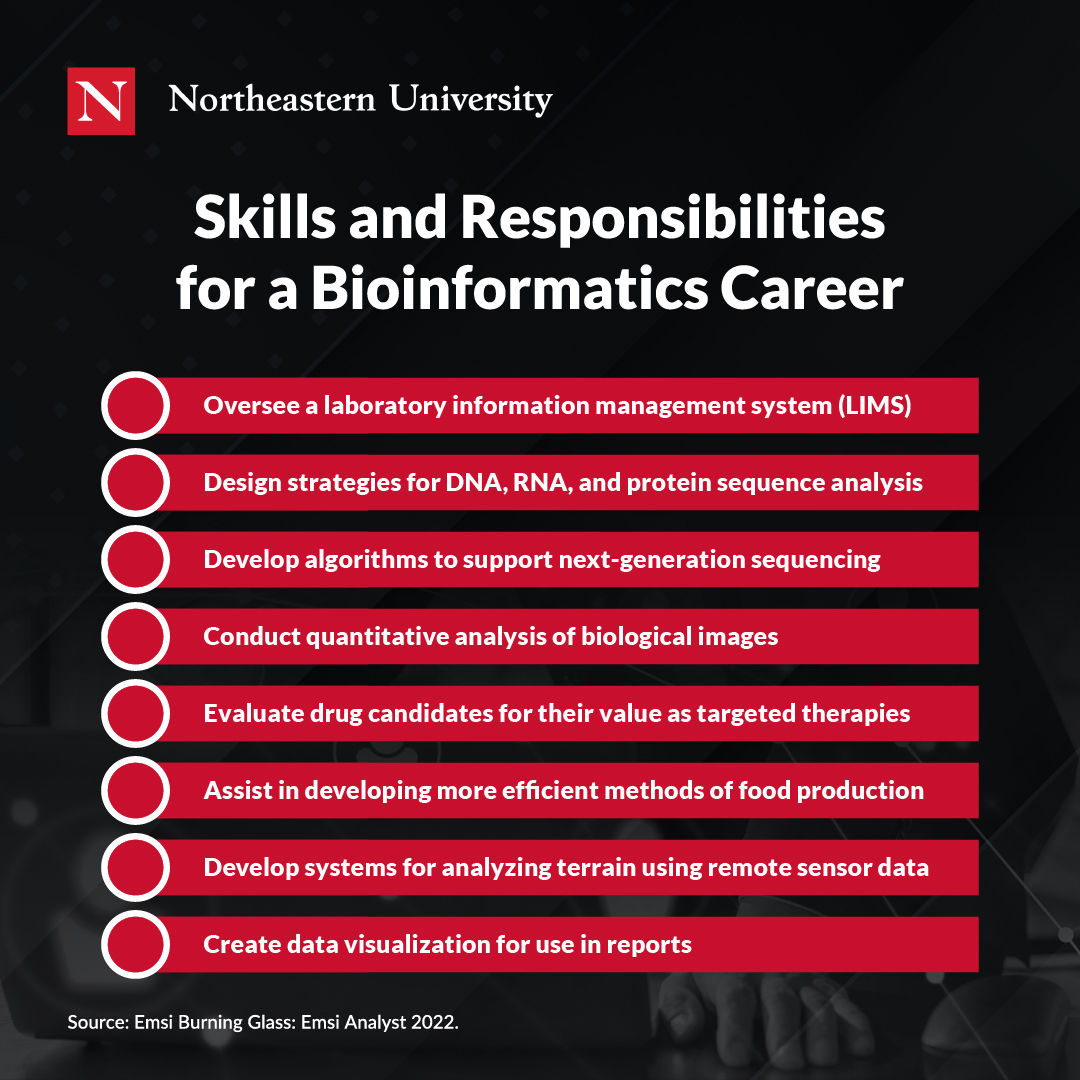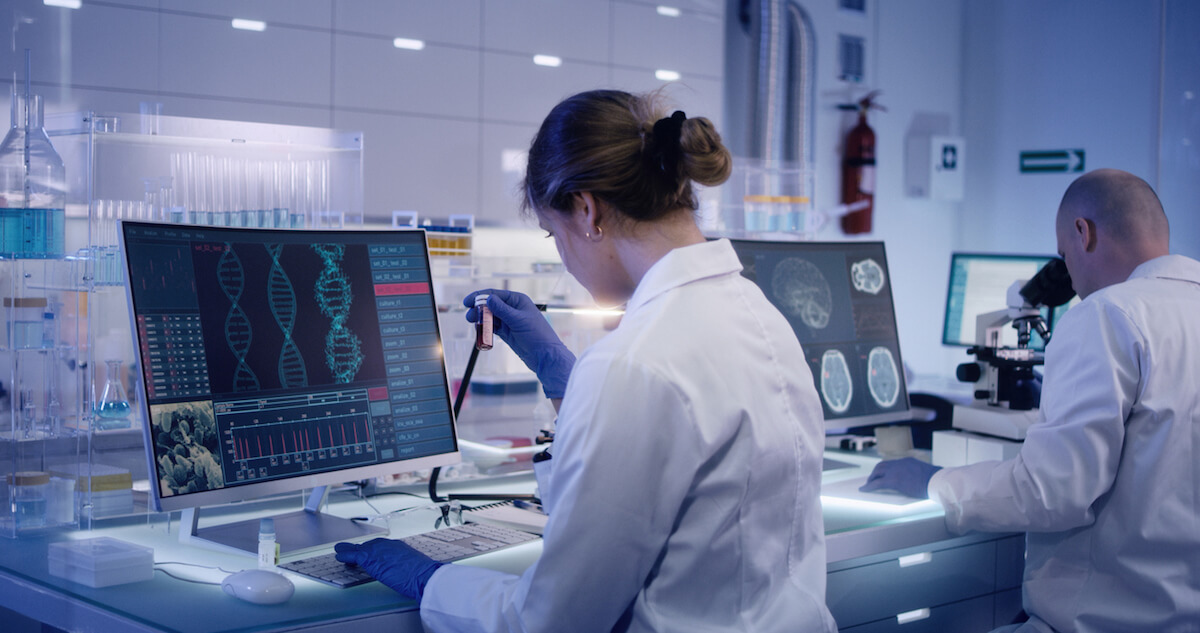Opportunities for high-paying and rewarding bioinformatics careers are growing. According to the Bureau of Labor Statistics, jobs in computer-based analysis are projected to grow 22 percent by 2030 (more than four times the national average), with the healthcare, pharmaceutical, and biotechnology fields leading the way. Other fields where bioinformatics skills play a critical role, such as microbiology or zoology and wildlife biology, are projected to keep pace with the national average.
But the prospects for bioinformatics careers extend beyond a handful of job titles.
“Bioinformatics is at the intersection of computer programming, big data, and biology,” says Stefan Kaluziak, an assistant professor of bioinformatics at Northeastern University. “Anything that happens in biology in the future will have some component of bioinformatics in it. Where you can go with a Master of Science in Bioinformatics is almost limitless.”
Due to the growing influence of bioinformatics on various industries, there are ample opportunities for those looking to pursue diverse careers in bioinformatics. To reap the benefits of the industry, it’s important to learn the day-to-day responsibilities and most important skills for these seven common bioinformatics jobs.
Advance Your Career with a Master’s in Bioinformatics
Be at the forefront of an industry that’s changing lives.
Career Paths for Bioinformatics
Generally, a bioinformatics specialist is responsible for managing and analyzing large sets of genomic data. The setting where that data analysis takes place can vary quite a bit, however.
- In the pharmaceutical and biotechnology industries, work typically involves exploring the human genome to detect how drugs may impact certain proteins within the body’s cells. Work often happens in a laboratory setting.
- In biology and zoology, the analysis focuses on animal and plant genomes and terrestrial data such as elevation and water availability, with an overall focus on environmental health and conservation. Bioinformatics engineers may work in a lab or out in the field.
- In academia, bioinformatics careers are related to experiments that may not have an immediate commercial benefit but could be used to drive future investigations in medical or biological research.
Skills and Responsibilities for a Bioinformatics Career
Bioinformatics professionals must be comfortable using bioinformatics tools. Kaluziak adds that familiarity with Linux is always a plus, especially paired with the ability to manage clusters of Linux servers or nodes that are used to store and process data. Familiarity with programming languages such as Python, R, and Perl is also valuable, as these languages are commonly used with large data sets. Additional responsibilities within the bioinformatics field are listed below.

Top Bioinformatics Careers and Salaries
The average salary for bioinformatics careers vary by geography and industry. Roles in pharma and biotech tend to pay more than roles in healthcare or academia, for example. Some jobs at colleges and universities may also require a PhD, while many industry roles will only require a master’s in bioinformatics along with experience.
In addition, many companies post bioinformatics roles with similar job descriptions and salaries but slightly different titles. For example, a bioinformatics scientist and data scientist may have similar responsibilities, while a bioinformatician and a bioinformatics developer may have similar salaries.
Here’s a look at seven common bioinformatics careers, along with their salaries and considerations for anyone seeking these types of roles.
1. Bioinformatics Scientist
Average base salary: $97,404
A bioinformatics scientist’s key responsibility is to develop software applications and databases to analyze biological data. It is the role most closely associated with the data scientist in industries outside of biology and biotech.
Coordinating with other scientists and professionals within the organization is a valuable skill for bioinformatics scientists. Maintaining extensive records of experiments and analyses is also an important part of the job, as it allows for easy review of past work to identify future research priorities.
Other elements of the day-to-day job may differ depending on where a bioinformatics scientist works. At a large firm such as a pharmaceutical company, there may be standardized workflows for data collection and analysis as well as templates for creating reports, Kaluziak notes. On the other hand, at a startup or smaller firm, the role may involve running experiments as well as performing tasks such as supporting the IT department.
2. Research Scientist
Average base salary: $83,565
Most often found in an academic setting or research organization, the research scientist typically conducts research in a laboratory setting that includes both control and experimental groups. Experiments can be done only after a proposal is peer-reviewed and approved for its methodology and validity to the scientific field. A background in bioinformatics is helpful for interpreting the results of an experiment, such as data collected from tests conducted on living specimens, and for summarizing observations in scientific papers.
Since the research scientist often conducts work that is not directly or immediately applicable to the business world, grant-writing and fundraising are useful skills for this bioinformatics role.
3. Biostatistician
Average base salary: $77,665
A biostatistician focuses on statistical design and analysis as it relates to research work. This role is also responsible for preparing reports that summarize the analysis and refer to any pertinent research methodologies. The work environment may be a hospital or research lab, and areas of focus may be epidemiology, genetics, or ecology.
The ability to create easy-to-read reports is a critical skill for a biostatistician, as the analysis is often presented to clients or other external stakeholders in addition to internal teams. The role is typically part of a larger research team, so interpersonal management and collaboration are also valuable skills.
4. Microbiologist
Average base salary: $79,260
Microbiologists study organisms such as bacteria and viruses that cannot be seen with the naked eye. Increasingly, this role focuses on how these organisms interact with their environment and impact human and animal health. Microbiologists typically work in an academic setting, and an advanced degree is often required to conduct independent research or supervise students or other laboratory professionals.
A background in bioinformatics can help microbiologists interpret anomalies and other patterns in their research data, which in turn can be used to identify areas of additional research or discover new ways that an organism may impact our health. In addition, since publishing scientific articles or papers is an important part of a microbiologists’ work, understanding how to display data and analyze it in an approachable way is a key part of the role.
5. Bioinformatician
Average base salary: $74,434
Among the many bioinformatics careers, a bioinformatician is most closely associated with managing data itself. This role is responsible for managing large databases, developing data frameworks, and creating and modifying algorithms. Their analysis is typically used for classifying components of a biological system such as DNA sequences or documenting protein expression.
Bioinformaticians should be well-versed in programming statistical models, combining data sets, and maintaining data integrity and security. Individuals in this role often collaborate with scientists and researchers to interpret and present data sets.
6. Zoologist or Wildlife Biologist
Average base salary: $64,650
These scientists study animals that are visible to the naked eye, whether it’s a single species or a larger group of animals. Work is often done in the field to observe how animals interact with each other, their surrounding environment, and with human populations. Zoologists or wildlife biologists are often employed by public agencies, universities, or private firms focused on conservation or farm protection. Non-standard work hours are common.
Data collection and analysis play a big part in this work, whether gathering specimens, studying migration patterns, or examining satellite and climate data. Knowledge of bioinformatics supports zoologists and wildlife biologists in conducting more in-depth analyses of population models, genetics, or the impact of habitat change.
7. Molecular Biologist
Average base salary: $62,478
A molecular biologist looks at individual cells and molecules in plants, animals, and humans, paying particular attention to how they interact. Individuals in this role typically work at a hospital, university, laboratory, or government agency, though some may work in a corporate setting. This research is often used to diagnose and treat diseases at a molecular level, particularly those caused by inherited genetic mutations.
Bioinformatics skills are helpful for the role of the molecular biologist due to the size of the human genome (more than 3 billion pairs of nucleotide bases) and the human proteome, or set of proteins in the human body (estimated at more than 20,000 combinations of up to 20 different amino acids). In addition, the ability to analyze text, images, or sound files can help molecular biologists generate results from large sets of raw data.
Advance Your Bioinformatics Career with a Master’s Degree
The Master of Science in Bioinformatics program at Northeastern University is designed to prepare students for a career in bioinformatics by combining coursework in biology, computer science, information technology, and business management with real-world experience. For students looking to pursue a degree in bioinformatics in a faster time frame, the Master of Science in Bioinformatics Experiential program serves as a fast-track alternative offering students the opportunity to earn a full master’s in just one year with embedded experiential learning opportunities like signature labs, residencies, co-ops, and capstone projects. Both program concentrations include healthcare informatics, biotechnology, chemoinformatics, and bioinformatics enterprise management skills.
To learn more, visit the 2-year program page or the 1-year program pages to see how an advanced degree can help you advance your bioinformatics career.






Related Articles
Why This Alum Decided to Earn His Master’s Degree in Computer Science
The Top 10 Highest-Paying Big Data Careers
Data Scientist vs. Data Analyst: What’s the Difference?